New NOAA Website Provides Marine Navigation Resources in a Central Location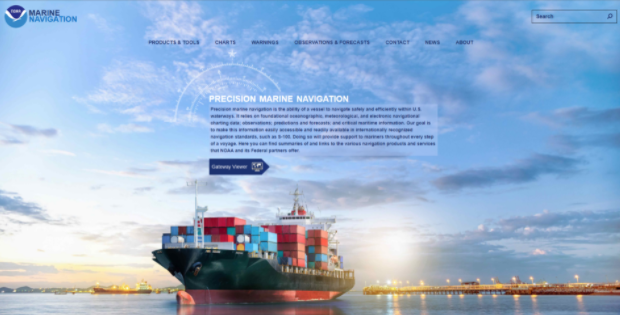
The image above depicts the homepage of NOAA’s new Precision Marine Navigation website A recently launched website from NOAA’s Precision Marine Navigation (PMN) program will improve the use and accessibility of NOAA’s marine navigation products and services. The website, Marine Navigation, includes links and short descriptions to NOAA’s various navigation resources, providing a one-stop shop that mariners can visit to get the data they need. Designed for shipping professionals and recreational boaters alike, the PMN program hopes the website will become a valuable tool to support all mariners in their navigation planning and decision making processes. Read more NOAA Celebrates 30 Years of PORTS and Expands Four Systems to Enhance Navigation Safety in Busy Shipping Areas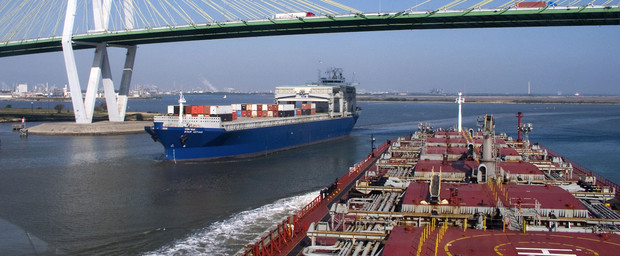
The image above depicts vessels transiting under the Fred Hartman Bridge in Texas In July, NOAA’s Physical Oceanographic Real-Time Systems (PORTSⓇ) celebrated its thirtieth anniversary. To commemorate the occasion, NOAA launched an updated PORTS landing page featuring the customizable MyPORTS application, a new system map, and an outreach video for the public. NOAA also worked with its local partners on the West Coast and in the Gulf of Mexico to add new sensors to existing PORTS that will improve marine navigation safety in these areas. The Humboldt Bay PORTS upgrade included a new side-looking current meter that provides mariners with real-time data to support commercial and recreational use inside Humboldt Bay. As part of the Los Angeles/Long Beach PORTS, a new air gap system consisting of two air gap sensors were installed on the new Gerald Desmond Bridge, which provides mariners with real-time data on bridge clearance within plus/minus an inch. An air gap system on the old, nearby Gerald Desmond Bridge will remain operational until that structure is dismantled. The Mobile Bay PORTS added a new visibility sensor in the middle of the bay at E Range Front Light. The addition of this valuable real-time data helps mariners, particularly from large cargo ships and assisting tug boats coming in and out of port, to navigate safely. As part of the Corpus Christi PORTS expansion, two new water level stations were added in the Viola Turning Basin and at the MODA Ingleside Energy Center. Read more Model Upgrade: Global Extratropical Surge and Tide Operational Forecast System Upgraded to Version Two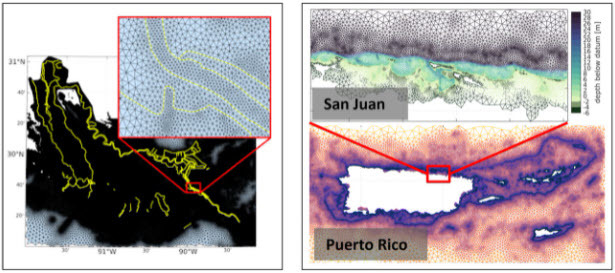
The two juxtaposed images above depict the upgraded Global ESTOFS Model In July 2021, the Global Extratropical Surge and Tide Operational Forecast System (Global ESTOFS) upgrade to version 2 was implemented into operations on the National Weather Service’s Weather and Climate Operational Supercomputing System. Global ESTOFS provides forecast guidance of the combined water level caused by storm surge and tides globally. Over the past several months, NOAA’s Office of Coast Survey Development Lab/Coastal Marine Modeling Branch/Storm Surge Modeling Team collaborated with the University of Notre Dame to implement many significant advancements in Global ESTOFS to improve model performance, resolution, and coverage. Some of the enhancements include: adding federal levees in southern Louisiana; improved spatial resolution and inclusion of a floodplain for Puerto Rico; output of depth-averaged current velocities for use in NOAA’s Nearshore Wave Prediction System; and improvements to coastal topobathy and bottom friction and subsequent performance in coastal flood forecasts. Users in both the disaster mitigation and marine navigation communities can expect much improved water level forecast guidance with this upgrade. With its new global coverage, the name of the model is planned to change to Global STOFS in July 2022. Global ESTOFS output is available on AWS and NOMADS, and visualization available on nowCOAST and this web portal. Read more Advancements in Survey Technology, Blue Economy, and More Discussed at Fall 2021 Virtual Hydrographic Services Review Panel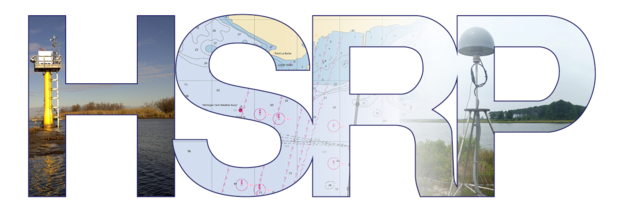
The image above depicts the acronym “HSRP” in large font, which stands for Hydrographic Services Review Panel NOAA’s Hydrographic Service Review Panel (HSRP), a federal advisory committee, convened virtually from September 1-2, 2021 to hear views from stakeholders and partners on NOAA’s navigation products and services, and topics including seafloor mapping, datum updates, wind energy development, surveying technology, and the Blue Economy. The meeting included two special sessions. The first focused on offshore wind energy development and NOAA’s role in supporting it. NOAA can help advance this mission by providing geospatial data though mapping and observations. The second session focused on new technology employed during nearshore shallow water surveys. Advances in lidar, uncrewed vessels, satellite derived bathymetry, and other technologies are enabling data to be gathered in areas that are too hazardous to send people in to survey. Dr. Rick Spinrad, NOAA’s recently appointed Administrator & Under Secretary of Commerce for Oceans and Atmosphere, shared his priorities with HSRP, including his vision for the Blue Economy. HSRP is a federal advisory committee that advises the NOAA administrator on products and services related to navigation services, water levels and currents, and global positioning. The director of NOAA’s Office of Coast Survey serves as the designated federal official of the panel. The panel will consider information from this meeting as it makes recommendations to NOAA’s administrator. Read more United States, Canada, and Mexico Submit Jointly Computed Geoid ModelThe geoid is a model of global mean sea level used to measure precise surface elevations. This summer the Experimental Geoid Model 2020 (xGEOID20) — the first geoid model jointly computed by the National Geodetic Survey, the Canadian Geodetic Survey of Natural Resources Canada, and the National Institute of Statistics and Geography of Mexico — was submitted to the International Service for the Geoid (ISG) for validation and dissemination to the scientific community. This new experimental geoid model is the culmination of years of collaboration and joint data processing between the U.S., Canada, and Mexico and heralds a new level of accuracy and interoperation among the countries’ geospatial data models. The xGEOID20 covers the entire region of North America. The new model provides improved accuracy and data for navigation, positioning, and the myriad applications of geodesy, including autonomous navigation, precision agriculture, civil surveying, early warning systems, and improved floodplain mapping. Read more NOAA Releases State of High Tide Flooding and Annual Outlook Report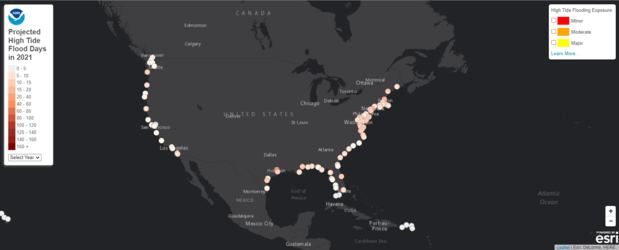
Image above depicts a US map of Projected High Tide Flood Days in 2021 U.S. coastal communities continued to see record-setting high-tide flooding in 2020, forcing residents and visitors to deal with flooded shorelines, streets and basements — a trend that is expected to continue into 2022. In July, NOAA released its 7th State of High Tide Flooding and Annual Outlook report that documents changes in high-tide flooding patterns from the previous year at NOAA tide gauges along the U.S. coast, and provides a flooding outlook for these locations for the coming year, as well as projections for the next several decades. High tide flooding, increasingly common due to years of relative sea level increases, occurs when tides reach anywhere from 1.75 to 2.00 feet above the daily average high tide and start spilling onto streets or bubbling up from storm drains. The report found that high tide flooding is now accelerating at 80% of locations along the East and Gulf Coasts. Fourteen locations, primarily in these regions, broke or tied their flood records in 2020. By 2030, high tide flooding is likely to be in the range of 7-15 days and by 2050, between 25-75 days. These long term outlooks are based on the range of relative sea level rise ‘more likely’ to occur by 2030 and 2050 using projections of the Fourth National Climate Assessment. Read more | 



Be the first to comment!